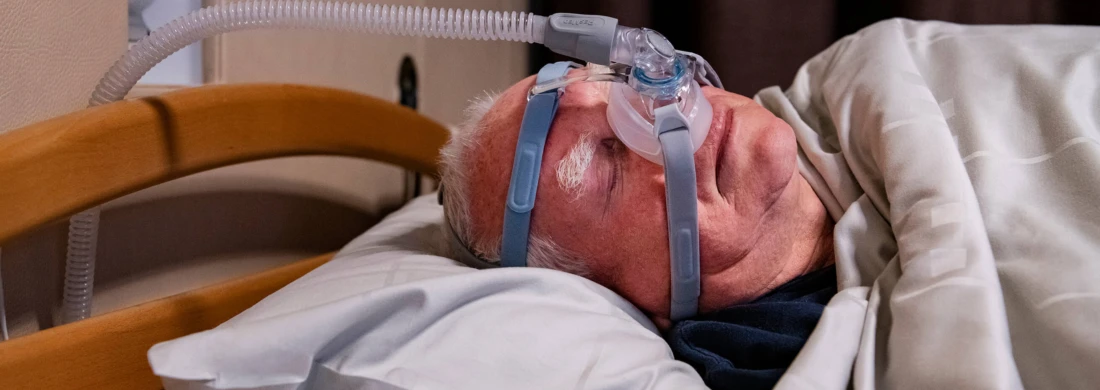Sleep apnea
An apnea is a pause in breathing. Sleep apnea means "temporarily stopping breathing during sleep." There are two forms of sleep apnea: obstructive sleep apnea and central sleep apnea. Obstructive sleep apnea (OSA) is the most common form of sleep apnea. This form is generally accompanied by loud snoring. In central sleep apnea (CSA), breathing is irregularly controlled by the brain. Sometimes, a combination of both forms occurs. Patients with either form can seek care at the Center for Sleep Medicine at Kempenhaeghe.
Obstructive Sleep Apnea (OSA)
In obstructive sleep apnea, there is a repeated obstruction in the throat during sleep. The structure of the throat, excess weight, and other factors determine whether obstruction occurs while sleeping. If this happens repeatedly during sleep and is accompanied by symptoms at night or during the day, it is classified as sleep apnea.
Symptoms that may occur at night include snoring, breathing pauses, frequent urination, shallow sleep, sweating, or unpleasant dreams.
Symptoms that may occur during the day include waking up unrefreshed, morning headaches, sleepiness, irritability, memory and concentration problems. These issues can affect work or relationships. Severe untreated OSA can have long-term negative health consequences and may lead to conditions such as high blood pressure.
OSA care is generally well-developed in secondary care, but a minority of patients experience more complex issues. The Center for Sleep Medicine provides specialized care for patients with obstructive sleep apnea, especially when diagnosis and treatment in secondary care have not been satisfactory.
Diagnosis
The diagnosis of OSA is based on symptoms and the results of a sleep study.
Treatments
The treatment of OSA depends on several factors. First, general lifestyle guidelines are important: maintaining a regular sleep schedule, limiting alcohol consumption, reducing excess weight, and avoiding sleep medication.
There are also various treatment options for OSA. The sleep specialist discusses the possible options with the patient:
- Positional therapy: The patient avoids sleeping on their back.
- MRA (Mandibular Repositioning Appliance): A dental device or mouthpiece that moves the lower jaw forward to create more space in the throat.
- CPAP (Continuous Positive Airway Pressure): A treatment using a mask that delivers positive air pressure to keep the throat open during sleep.
- Surgery: Various surgical procedures for sleep apnea are performed in the Netherlands.
Care Products for Adults with Sleep Apnea
Some key care products include:
- Improving symptoms in OSA patients: For patients whose CPAP therapy effectively controls breathing but who continue to experience fatigue or sleepiness, we offer a comprehensive diagnostic approach to identify and treat other causes of sleep disturbances, such as insomnia or restless legs syndrome.
- Better control of breathing disorders: In some patients, the apnea-hypopnea index (AHI), which measures the severity of sleep apnea, remains too high despite therapy. We conduct video polysomnography to more accurately diagnose the cause of breathing problems. This may include esophageal pressure measurements and CO2 monitoring.
- Adherence to CPAP treatment: Some patients have difficulty tolerating CPAP therapy. In such cases, we provide intensive educational support and guidance from nurse specialists to improve therapy adherence. Sometimes, CPAP pressure is adjusted during a short clinical stay of up to three nights.
CPAP Treatment for Patients Requiring Additional Support
Some OSA patients, such as individuals with mild intellectual disabilities, language barriers, or psychosocial issues, require more time and guidance when starting CPAP therapy. We provide specialized care to ensure these patients receive successful treatment.
Sleep Apnea in Children and Individuals with Intellectual Disabilities
In children and individuals with intellectual disabilities, OSA can sometimes be more challenging to diagnose and treat. We have expertise in the diagnosis and treatment of these groups, providing personalized care, including adapted polysomnography and support in initiating PAP therapy (Positive Airway Pressure).
Central Sleep Apnea (CSA)
In addition to OSA, we also treat central sleep apnea (CSA), where breathing problems are not caused by an airway obstruction but by a failure in respiratory regulation in the brain. CSA can be normocapnic (normal CO2 levels in the blood) or hypercapnic (elevated CO2 levels). Treatment often consists of CPAP therapy, oxygen therapy, or Adaptive Servo-Ventilation (ASV) as a last step.
Diagnostic Techniques for Sleep Apnea
We use various advanced diagnostic techniques for sleep apnea, including:
- Polysomnography (PSG): A comprehensive sleep study that monitors breathing, heart rate, and brain activity, often combined with video recordings.
- Esophageal pressure measurement and transcutaneous CO2 monitoring: Used in more complex breathing disorders to better understand the underlying cause.
- CPAP pressure titration: A method in which the pressure settings of CPAP therapy are precisely adjusted during a sleep study.
